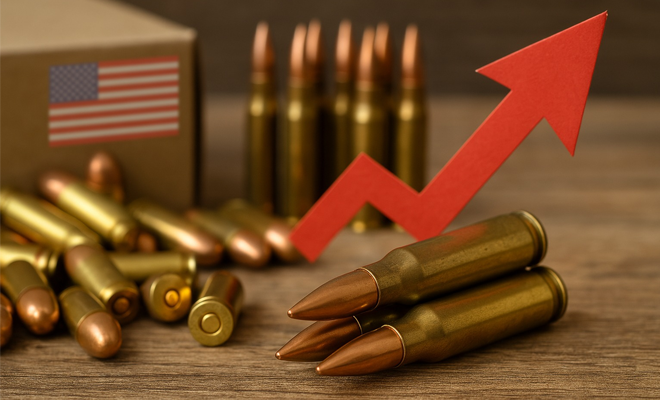How the Recent U.S. Tariff Increase is Affecting Ammo Prices

The recent tariff increases imposed by the U.S. government under President Donald Trump are poised to significantly impact ammunition prices in the United States.
These tariffs, targeting a broad range of imports, have introduced new economic dynamics that are particularly influential in the ammunition market, which relies heavily on foreign manufacturers.
Immediate Price Increases
The immediate effect of these tariffs is evident in the rising costs of imported ammunition. According to the team at Black Basin Outdoors they have received news industry insiders of certain Tela Ammo products showing immediate 10% raise in prices, attributed to a 10% tariff on imports from Azerbaijan. This 10% hike directly reflects the tariff’s impact on pricing.
Broader Market Implications
The U.S. ammunition market predominantly sources lower-priced products from foreign imports. With the implementation of these tariffs, significant price increases for foreign ammunition are anticipated in the coming weeks and months. This trend is expected to affect both retailers and consumers, leading to higher prices across the board.
Strategic Considerations for Importers and Retailers
For importers and retailers, these developments necessitate a reassessment of pricing and marketing strategies. If the tariffs remain in place long-term, current inventory acquired before the tariff impositions could influence the market additionally. This scenario will affect prices throughout the industry and force retailers to act.
At Black Basin Outdoors, they understand how critical affordable and available ammunition is to our customers. They are staying on the forefront of this developing situation and actively monitoring the evolving landscape. As a trusted ammo retailer, they’re committed to providing the best possible prices despite the challenging market conditions. Black Basin Outdoors is also doing what they can to ensure a steady and reliable supply of ammunition, so American shooters can keep doing what they love without disruption.
Tariff Rates by Country and Manufacturer
The tariffs vary by country and manufacturer, affecting a wide range of suppliers:
Tariff Rates by Country and Manufacturer
Serbia 37%, Manufacturers: PPU
Bosnia & Herzegovina 36%, Manufacturers: Igman
South Korea 25%, Manufacturers: PMC
European Union 20%, Manufacturers: Belom, Rio, ATS, Ruag/Ammotec/Swiss P
Philippines 18%, Manufacturers: Armscor
Czech Republic 10%, Manufacturers: Sellier & Bellot
Brazil 10%, Manufacturers: Magtech
Turkey 10%, Manufacturers: ZSR, BPS, Wolf 9mm, Turan, Sterling/Turac
Azerbaijan 10%, Manufacturers: Tela
Mexico 0%, Manufacturers: Aguila
These varying rates highlight the uneven impact on different suppliers, influencing decisions on sourcing and pricing strategies. Especially interesting is that except previous 10% raise for Mexico, there are no new changes for products coming from the South of the border.
Industry and Political Reactions
The broader economic implications of these tariffs have sparked diverse reactions. Critics argue that such measures could harm American consumers and the economy by increasing prices and potentially triggering trade retaliation. For instance, Senator Ted Cruz has expressed concerns that these protectionist policies might lead to a global trade war, potentially causing a recession and significant political consequences for the Republican Party in the upcoming midterm elections.
Conversely, supporters believe the tariffs are necessary to rectify trade imbalances and could revitalize domestic manufacturing and job opportunities. The administration asserts that over 50 countries have sought to initiate trade negotiations with the U.S. following the tariff announcements, viewing this as a strategic effort to enhance U.S. leverage in global trade.
Conclusion
The recent tariff increases are set to have a profound impact on ammunition prices in the U.S., affecting importers, retailers, and consumers alike. Stakeholders must navigate these changes strategically, considering both immediate pricing adjustments and long-term market positioning. As the situation evolves, continuous monitoring of policy developments and market responses will be crucial for informed decision-making.












